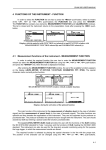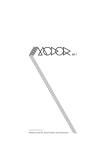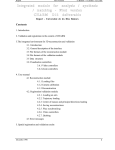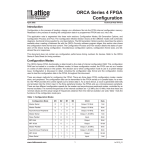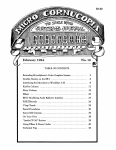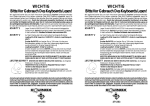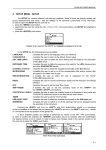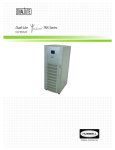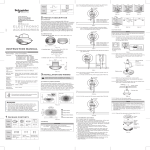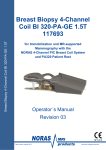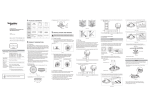Download 7 SAVING MEASUREMENT RESULTS - FILE
Transcript
SVAN 958 USER MANUAL 7 SAVING MEASUREMENT RESULTS - FILE The registration of the measurement results is an essential task for the efficient use of the instrument. All available measurement results can be stored in the FLASH type memory of the instrument. There are two main ways for storing the measurement data in the instrument: 1. Saving files in the FLASH DISC using the FILE list. 2. Logging data in the files of the logger. Notice: The instrument’s logger memory is independent from the FLASH DISC memory. The capacity of available memory is equal to 32 MB. Saving files In the case of the SVAN 958 instrument there are few different types of files containing data: • from Sound Level Meter mode; • from Vibration Level Meter mode; • from 1/1 OCTAVE analysis; • from 1/3 OCTAVE analysis; • from FFT analysis; • from RT60 measurements; • stored in the instrument’s logger. Notice: The logger files are created automatically (the usage of the SAVE position is not required). Each file consists of some elements, which are the same for all kind of files: • a file header; • the unit and software specification; • the user’s text stored together with the measurement data; • the parameters and global settings; • the special settings for channels; • the marker of the end of the file. The other elements of the file structure depend on the type of the file (SLM, VLM, 1/1 OCTAVE or 1/3 OCTAVE analysis, logger) and on the setting of SAVE STATISTIC (path: MENU / FILE / SAVE OPTIONS / SAVE STATISTIC). These elements are as follows: • the main results; • the results coming from 1/1 OCTAVE analysis; • the results coming from 1/3 OCTAVE analysis; • the results from FFT analysis; • the results from RT60 mode; • the statistics header; • the results of statistical analysis; • the header of the statistical analysis performed in 1/1 OCTAVE or 1/3 OCTAVE analysis; • the results of the statistical analysis performed in 1/1 OCTAVE or 1/3 OCTAVE analysis; • the header of the logger’s file; 7-1 SVAN 958 USER MANUAL • _ the data stored during the measurements in the files of the logger. Notice: The detailed description of all types of file structures is given in the Appendix B. Storing the measurement results as files in the instrument’s FLASH DISC can be done by means of the FILE list. In order to open this list the user has to: • press the <Menu> push-button, • select from the main list, using the < >, < > (or < >, < >) push-buttons, the FILE text (highlight it inversely), • press the <ENTER> push-button. Main list with FILE text highlighted (displayed inversely) The FILE list contains the following items: SAVE enables one to save the measurement results as a file in the instrument memory; SAVE OPTIONS enables one to set the options of the measurement result savings; LOAD FILE enables one to load to the working space of the instrument’s memory the measurement results saved in a file; enables one to select and present the results stored in the logger’s files; LOGGER VIEW DELETE enables one to delete a selected file from the instrument’s memory; DELETE ALL enables one to delete all files from the instrument’s memory; DEFRAGMENTATION enables one to recover the memory, which was used by the deleting files; CATALOGUE SAVE SETUP enables one to overview the catalogue of the files saved in the instrument’s memory; informs the user about the capacity of the instrument’s memory still available for storing the measurement results; enables one to set the configuration of the meter; SETUP OPTIONS enables one to switch on the saving of user filters coefficients; LOAD SETUP enables one to load to the configuration saved in a file. FREE SPACE Pressing the <Shift> and < > (or <Shift> and < >) results in a movement to the first position of the opened list and pressing the <Shift> and < > (or <Shift> and < >) results in a movement to the last position of the opened list. FILE list In each available position any change is performed by means of the < >, < > push-buttons. In order to confirm the selection the <ENTER> push-button has to be pressed. After this confirmation, the opened window or list is closed. In order to ignore any changes made in the opened window or list the user has to press the <ESC> push-button. 7-2 SVAN 958 USER MANUAL 7.1 Saving files in the instrument’s memory - SAVE and AUTO NAME The SAVE (path: MENU / FILE / SAVE) is used for storing data in the internal non-volatile (FLASH DISC) memory as a file (see Appendix B for the file formats). In order to enter the position the user has to select the SAVE text in the FILE list, using the < > (or < >) push-button (the window is opened also by pressing <Alt> together with <ENTER> after the measurement). After the selection the <ENTER> push-button must be pressed. FILE list with SAVE text highlighted (displayed inversely) The additional function for results saving - AUTO NAME (save a file with the name increased by one) is available after selecting the AUTO NAME text (with < >, < > push-buttons) and switching it on (using < > push-button). The return to the FILE list is possible after pressing the <ESC> push-button. SAVE window opened The name of the file, in which the measurements or the analysis results are to be saved, is displayed in the second line (FILE NAME). The default name for a file is displayed in the case of the first entering to this position (after power on) and the last saved file’s name – in the case of the next entering. It is possible to edit this name in two ways: full and with AUTO NAME option. The SAVE window with FILE NAME edition is presented on the Figure below. The displayed inversely character is currently edited. The < >, < >, < >, < > and <Shift> push-buttons are used for editing the name which cannot exceed 8 characters. Displays during the file’s name edition The user can select the proper position of the character in the edited text using the < >, < > pushbuttons. The available ASCII characters can be changed using the < >, < > push-buttons. The subsequent big letters, digits, space and underline appear on the display in the inversely displayed position after each pressing of the mentioned above push-buttons. The empty space is created for the introduction of a new character in the edited name (the Insert operation is executed) when the <Shift> push-button is pressed together with the < >. Displays in FILE NAME edition after pressing <Shift> and < > push-buttons 7-3 SVAN 958 USER MANUAL _ The character, which is highlighted (displayed inversely), is deleted from the edited name (the Delete operation is executed) when the <Shift> and < > push-buttons are pressed. Displays in FILE NAME edition after pressing <Shift> and < > push-buttons The edited name is accepted and the file is saved after pressing the <ENTER> push-button (cf. the description of the AUTO NAME function). The instrument waits then for a reaction of the user (any push-button should be pressed except the <Shift> and <Alt>). All changes introduced to the file name during the edition are ignored after pressing the <ESC> push-button. This pressing causes the return to the list from which the SAVE option was entered. The simplified edition consists in the addition at the end of the file name the natural number, increased by one after each saving. This option is available after selecting the AUTO NAME text (with < >, < > push-buttons) and switching it on (using < > one). SAVE window with AUTO NAME function selection The presented below message (Fig. a) is displayed after pressing the <ENTER> push-button in the case when no measurements were performed and there are no results to be saved. The operation cannot be done also in a case when the file of the selected name already exists in the instrument’s memory (Fig. b). The instrument then waits for the reaction of the user (any push-button should be pressed except the <Shift> one) and after pressing a push-button it returns to the SAVE position. a) b) Displays after SAVE operation when there is no results to save (a) and the file with the selected name already exists in the instrument’s memory (b) The data are saved in the file with the name increased by one in relation to the name displayed after switching on of the AUTO NAME option and after pressing the <ENTER> push-button (if the instrument is not measuring and there are the results to be stored). The following message containing the name of the file and the operation performed is displayed after the saving of the file: Display after the execution of SAVE operation 7-4 SVAN 958 USER MANUAL Another message is displayed after successful saving of the file in the memory and then the instrument waits for the reaction of the user (any push-button should be pressed except the <Shift> and <Alt>) and after pressing a push-button it returns to the FILE list. The assumptive file’s name is displayed after repeated enter to the SAVE position of the FILE list (after pressing the <ENTER> pushbutton). a) b) c) SAVE window AUTO NAME option selected (a), after saving the file with the increased name (b) and after repeated enter to SAVE window (c) It is not possible to store the data in the file, which already exists, when the REPLACE position is not active ([ ]). The presented below message is displayed after pressing the <ENTER> push-button in the case when during the name edition process the user selected the name which was used before. The instrument then waits for the reaction of the user (any push-button should be pressed except the <Shift> and <Alt>) and after pressing a push-button it returns to the FILE list. b) a) Displays after the file’s name selection (a) and with the message if REPLACE option is not active (b) 7.2 Controlling the data storing in the instrument’s memory - SAVE OPTIONS The SAVE OPTIONS (path: MENU / FILE / SAVE OPTIONS) is used for the selection of the options of data storing in the FLASH DISC memory of the instrument. The window is opened after pressing the <ENTER> push-button when the SAVE OPTIONS text in the FILE list is displayed inversely (selected using the < >, < > (or < >, < >) push-buttons). The return to the FILE list is possible after pressing the <ESC> push-button. FILE list with SAVE OPTIONS text highlighted (displayed inversely) It is possible to replace the existing in the memory file by the new one with the same name (the REPLACE position), to add to the results the statistics of the measurements (the SAVE STATISTICS position, valid only for sound measurements) and to save automatically the results of the measurements (the AUTO SAVE position). The position of the sub-list is changed after pressing the < >, < > pushbuttons. In order to confirm the selection the <ENTER> push-button has to be pressed. Such pressing closes also the opened window. 7-5 SVAN 958 USER MANUAL 7.2.1 _ Saving files in RAM memory - RAM FILE The RAM FILE enables the user to save the results of the measurement in the special file in RAM memory (the name of the file is defined as a “RAMfile”). The activation or deactivation of the RAM FILE is done by pressing the <>, <> push-buttons. This option is useful when remote reading is necessary; available values: [√ √] or [ ]. <> SAVE OPTIONS windows with the selection of RAM FILE parameters 7.2.2 Controlling of the measurement statistics savings - SAVE STATISTICS The SAVE STATISTICS is used to set self-saving, together with the sound measurement results, the statistics of the measurements ([√ √]) or to switch off ([ ]) this possibility. Together with the sound measurements, 100-class statistics is performed (the values named from L01 to L99). The statistics are not calculated for the vibration measurements. The activation or deactivation of the SAVE STATISTICS is done by pressing the < >, < > push-buttons. Notice: This position was created to save the memory of the instrument in the case when the knowledge of the statistics is not necessary. Each registration of the statistics requires 600 bytes of the memory! < > SAVE OPTIONS windows with the selection of SAVE STATISTICS After pressing the <ENTER> push-button the selections made in any position of the list (in particular also in the SAVE STATISTIC) are confirmed and the window is closed. 7.2.3 Saving minimum values in the spectrum - MIN SPECTRUM The MIN SPECTRUM appears on the display in the case of 1/1 OCTAVE and 1/3 OCTAVE mode and it enables the user to save the lowest values of the instantaneous spectrum (calculated with 100milliseconds time step), which occurred during the INT. PERIOD set in the INPUT list (path: MENU / INPUT / MEASUREMENT SETUP / INT. PERIOD). The activation or deactivation of the MIN SPECTRUM is done by pressing the < >, < > pushbuttons. After pressing the <ENTER> push-button the activation is confirmed. The SAVE OPTION window is closed ignoring all settings made in it after pressing the <ESC> push-button. <> SAVE OPTIONS windows with the selection of MIN. SPECTRUM saving 7-6 SVAN 958 USER MANUAL To see the MINIMUM values on the display during the real time 1/1 OCTAVE or 1/3 OCTAVE analysis the user has to activate the option in the DISPLAY list (path: MENU / DISPLAY / DISPLAY SETUP / CHANNEL x / SPECTRUM VIEW / MINIMUM). 7.2.4 Saving maximum values in the spectrum - MAX SPECTRUM The MAX SPECTRUM appears on the display in the case of 1/1 OCTAVE and 1/3 OCTAVE mode and it enables the user to save the highest values of the instantaneous spectrum (calculated with 100milliseconds time step), which occurred during the INT. PERIOD set in the INPUT list (path: MENU / INPUT / MEASUREMENT SETUP / INT. PERIOD). The activation or deactivation of the MAX SPECTRUM is done by pressing the < >, < > pushbuttons. After pressing the <ENTER> push-button the activation is confirmed. The SAVE OPTION window is closed ignoring all settings made in it after pressing the <ESC> push-button. <> SAVE OPTIONS windows with the selection of MAX. SPECTRUM saving To see the MAXIMUM values on the display during the real time 1/1 OCTAVE or 1/3 OCTAVE analysis the user has to activate the option in the DISPLAY list (path: MENU / DISPLAY / DISPLAY SETUP / CHANNEL x / SPECTRUM VIEW / MAXIMUM). 7.2.5 Replacement of the existing files by the new ones - REPLACE The result of the attempt to save the file with the name, which already exists in the memory, depends on the setting of the REPLACE. It is possible to erase the old file and to save the new one with the same name if the position is active ([√ √]). The message is displayed that such operation is not available in the case when this position is not active ([ ]) – cf. the description of the SAVE. The activation or deactivation of the REPLACE is done by pressing the < >, < > push-buttons. <> SAVE OPTIONS windows with the selection of REPLACE After pressing the <ENTER> push-button the selections made in any position of the window (in particular also in the REPLACE position) are confirmed and the sub-list is closed. In the case when the AUTO SAVE option was active ([√ √]), after pressing the <ENTER> push-button the FILE NAME window is opened for editing the names for AUTO SAVE files. The SAVE OPTION window is closed ignoring all settings made in it after pressing the <ESC> push-button. The next position from the SAVE OPTIONS window becomes available after pressing the < > push-button. 7-7 SVAN 958 USER MANUAL 7.2.6 _ Controlling of the measurement results savings - AUTO SAVE Using the AUTO SAVE one can set the self-saving of the measurement results ([√ √]) or to switch off ([ ]) this possibility. The activation or deactivation of the AUTO SAVE position is done by pressing the < >, < > push-buttons. This position was also established in order not to waste too much memory of the instruments when the self-saving is not necessary. <> SAVE OPTIONS windows with the selection of AUTO SAVE parameters The window for the edition of the base name for the self-saved files is opened (the AUTO FILE NAME) after pressing the <ENTER> push-button in the case when the AUTO SAVE position is activated. The name of the AUTO SAVE files is up to eight characters long starting with the special character @. Displays after entering FILE NAME edition mode for the files saved with AUTO SAVE option active (after pressing <ENTER> push-button in SAVE OPTIONS window, AUTO SAVE switched on) When the AUTO SAVE option is not active (OFF), after pressing the <ENTER> push-button the instrument returns to the FILE list. 7.2.7 Direct access to SAVE / AUTO NAME function - DIRECT SAVE The DIRECT SAVE enables one to save measurement results by the simultaneous pressing of the <ENTER> and <Alt> push-buttons after measurement. If this option is not active ([ ]), after pressing these push-buttons the SAVE window is accessed (if the measurements are not performed). If the option is active ([√ √]), after pressing the <ENTER> and <Alt> push-buttons the results are saved in the file with the automatically incremented name and the proper message is displayed for a few seconds. The proper setting of the DIRECT SAVE is done by pressing the < >, < > push-buttons. < > SAVE OPTIONS windows with the selection of DIRECT SAVE 7.3 Loading the files with the measurement results - LOAD FILE The LOAD (path: MENU / FILE / LOAD) is used for loading data file from the FLASH DISC (e.g. for the verification or comparison). The position is opened after pressing the <ENTER> push-button when the LOAD text in the FILE list is displayed inversely (selected using the < >, < > (or < >, < >) push-buttons). The return to the FILE list is possible after pressing the <ESC> push-button. 7-8 SVAN 958 USER MANUAL FILE list with LOAD FILE text highlighted (displayed inversely) Notice: It is not possible to load the file during the execution of the measurements. On such attempt the message: „measurement in progress / MEASUREMENT IN PROGRESS” is displayed for about 2 seconds. After pressing the <ENTER> push-button the instrument checks its current state. In the case when the measurements are performed, the file loading is impossible. In such case, the message with the changing letters is displayed (see below) and the instrument returns after few seconds to the list from which the LOAD was called. Displays with the message stating the reason for unfeasibility of the required operation In the case when the instrument memory is empty (no file is stored), the NO FILES text is displayed after entering LOAD and the instrument waits for the reaction of the user. The user should press then the <ESC>, <ENTER> or <Start / Stop> push-button. Displays during the execution of LOAD FILE operation The text informing the user that file was loaded from the internal memory of the instrument is given in the first line. The current number of the file and the total number of the saved files is displayed inversely in the second line together with the name of the file. The type of the current file (LEVEL METER, 1/1 OCTAVE, 1/3 OCTAVE etc.) and measure mode in each of four channels (Sound or Vibration) are given in the third line. If the file contains the results from the logger, the name of the logger file is displayed at the right end of the fourth line. Date and time of the SAVE operation is displayed in the fifth line. The size of the loaded file is given in the sixth line. The change of the current file with the unit step can be done after pressing the < >, < > pushbuttons. After pressing the < > with <Shift> push-button the first file is available and after pressing the < > with <Shift> push-button - the last one is displayed. Displays during the overview of the file list 7-9 SVAN 958 USER MANUAL _ The name of the file is accepted and the file is loaded after pressing the <ENTER> push-button. After successful end of loading operation instrument waits for the reaction of the user (any push-button should be pressed except the <Shift> and <Alt>) and after pressing a push-button it returns to the FILE list. .. Execution of the LOAD FILE operation The next message is displayed after successful end of loading operation. The instrument waits for the reaction of the user (any push-button should be pressed except the <Shift> one) and after pressing a push-button it returns to the FILE list. 7.4 Checking the contents of the loaded file - LOGGER VIEW The LOGGER enables the user to examine the contents of the logger files saved in the internal memory of the instrument. In order to open the window the user has to press the <ENTER> push-button when the LOGGER VIEW text is displayed inversely. FILE list with LOGGER VIEW text highlighted The storage type (INTERNAL) is displayed in the first line. The current number of the logger file, the total number of the saved files and the name of the file are displayed in the second line. After pressing the < > with <Shift> push-button the first file is available and after pressing the < > with <Shift> pushbutton - the last one is displayed. Date and time of the SAVE operation is displayed in the third and fourth line. The size of the file is displayed in the fifth line. The number of records (one record is saved after each period equal to logger step) is displayed in the last line. The change of the current file with the unit step can be done after pressing the < >, < > push-buttons. In the right corner, in the brackets, the number of saved logger results in each channel is displayed (e.g.: (5)rvR in the first line means that from the first channel all five available logger results are stored in memory and, additionally, rpm, vector and spectrum (RMS) are also saved in the selected logger file). <> <> LOGGER VIEW windows with the selection of the logger file to be viewed The results from logger’s file, coming from different channels, are changed after pressing the < > or < > push-buttons – after each pressing the result from the next channel is displayed. 7-10 SVAN 958 USER MANUAL < > < > < > Selection of the logger plot from different channels 7.5 Removing a file with the measurement results from memory - DELETE The DELETE (path: MENU / FILE / DELETE) is used to remove a file from memory. After pressing the <ENTER> push-button the instrument checks its current state. In the case when the measurements are performed, the DELETE position entering is impossible. In such case, the message with the changing letters is displayed (see below) and the instrument returns after few seconds to the list from which the DELETE was called. FILE list with DELETE text highlighted (displayed inversely) In the DELETE window, there are two elements: the RESULT FILES with the measurement results and the SETUP FILES with the saved setups of the instrument. In order to enter the selected sub-list the user has to select the proper text (to display it inversely) using the < >, < > (or < >, < >) pushbuttons and then press the <ENTER> one. The DELETE window is closed and the instrument returns to the FILE list after pressing the <ESC> one. DELETE windows opened with RESULT FILES and SETUP FILES selected After pressing the <ENTER> push-button the instrument checks its current state. In the case when the measurements are performed, the RESULT FILES or SETUP FILES entering is impossible. In such case, the message is displayed and the instrument returns after few seconds to the DELETE window. Displays with the message stating the reason for unfeasibility of the required operation In the case when the instrument memory is empty (no file is stored), the NO FILES text is displayed after entering DELETE and the instrument waits for the reaction of the user. The user should press then the <ESC>, <ENTER> or <Start / Stop> push-button. 7-11 SVAN 958 USER MANUAL _ DELETE window when the memory of the instrument is empty The same data about the existing in the instrument files as in the LOAD window are displayed on the display after successful opening the DELETE window (pressing the <ENTER> push-button). In the consecutive lines of the display the memory in which the results are saved in (INTERNAL), the current file number, the total number of the files, the file name, the file type, date and period of registration and the file size are presented. The change of the current file with the unit step can be done pressing the < >, < > push-buttons. After pressing the < > with <Shift> push-button the first file is available and after pressing the < > with <Shift> push-button - the last one is displayed. The return to the FILE list is possible after pressing the <ESC> push-button. DELETE windows with the selection of the file to be deleted The name of the file is accepted and the file is deleted after pressing the <ENTER> push-button. The message is displayed after the successful end of the operation. The instrument waits for the reaction of the user (any push-button should be pressed except the <Shift> one) and after pressing a push-button it returns to the FILE list. Execution of DELETE operation After the execution of the result files removing from the memory usually the FILES FREE memory (path: MENU / FILE / FREE SPACE) rests the same as before the deletion but TOTAL AVAILABLE memory is increased. It is because erased file was located somewhere inside the file’s space. The file is no longer accessible but the recuperated memory is still unused for the next saving. All new files are stored starting at the end of the last saved file. The memory becomes available after the defragmentation process (path: MENU / FILE / DEFRAGMENTATION) in which all files are moved to the continuous space. In order to illustrate it let us consider the result file named 02JAN5 file, which is 746 bytes long. The TOTAL AVAILABLE is increased after the DELETE operation but the LOGGER FREE rests unchanged. T Execution of the 02JAN5 file deletion and the influence of this process on the memory space 7-12 SVAN 958 USER MANUAL 7.6 Removing all files with measurement results from memory - DELETE ALL The DELETE ALL (path: MENU / FILE / DELETE ALL) is used to remove all files from memory. In order to enter the position the user has to select the DELETE ALL text in the FILE list, using the < >, < > (or < >, < >) push-buttons and press the <ENTER>. FILE list with DELETE ALL text highlighted (displayed inversely) It is possible to select RESULT, SETUP and LOGGER files to be deleted. The selection is made with < >, < >) push-buttons. The confirmation is made with pressing <ENTER>. DELETE ALL windows and the selection of the files to be deleted The instrument requests the confirmation of the operation after entering this position (after pressing the <ENTER> push-button). The next pressing of the <ENTER> push-button, when the NO option is selected, causes the closing of the position and the return to the FILE list. The selection of the NO or YES option is possible using the < >, < > push-buttons. The return to the FILE list is possible after pressing the <ESC> push-button. Displays during the execution of DELETE ALL operation After pressing the <ENTER> push-button the instrument checks its current state. In the case when the measurements are performed, the execution of the DELETE ALL operation is not possible. In such case, the message with the changing letters is displayed (see below) and the instrument returns after few seconds to the list from which the DELETE ALL was called. Displays with the not possible confirmation of DELETE ALL order during the measurement The <ENTER> push-button pressing, when the YES option is selected and the instrument is not performing the measurements, deletes all existing files. In this case, the text displayed below is presented. In this time, the instrument recovers and clears the memory, which was used by saved files. 7-13 SVAN 958 USER MANUAL _ Displays during the execution of DELETE ALL operation and after this execution The message is displayed after the successful execution of the operation. The instrument waits for the reaction of the user (any push-button should be pressed except the <Shift> and <Alt>) and after pressing a push-button it returns to the FILE list. 7.7 Memory merging - DEFRAGMENTATION The DEFRAGMENTATION (path: MENU / FILE / DEFRAGMENTATION) is used to merge the blocks of the memory which were released after the delete operation. In order to enter the position the user has to select the DEFRAGMENTATION text in the FILE list, using the < >, < > (or < >, < >) push-buttons and press the <ENTER>. FILE list with DEFRAGMENTATION text highlighted The instrument requests the confirmation of the operation after entering this position (after pressing the <ENTER> push-button). The next pressing of the <ENTER> push-button, when the NO option is selected, causes the closing of the window and the return to the FILE list. The selection of the NO or YES option is possible using the < >, < > push-buttons. The return to the FILE list is possible after pressing the <ESC> push-button. Displays before the execution of DEFRAGMENTATION operation The <ENTER> push-button pressing, when the YES option is selected and the instrument is not performing the measurements, merges the memory. The presented below message is displayed in the case when the operation is not required. The instrument waits for the reaction of the user (any pushbutton should be pressed except the <Shift> and <Alt>) and after pressing a push-button it returns to the FILE list. The operation is not executed in a case when FREE SPACE is equal to TOTAL AVAILABLE. Display in the case when DEFRAGMENTATION operation is not required 7-14 SVAN 958 USER MANUAL In the case when the DEFRAGMENTATION operation is performed, the following texts are displayed (see below). Displays during the execution of DEFRAGMENTATION operation In this time, the instrument recovers, clears and merges in one block the memory, which was used by the deleted files. The presented below message is displayed after successful memory merging (see Fig. c). The instrument waits for the reaction of the user (any push-button should be pressed except the <Shift> and <Alt>) and after pressing a push-button it returns to the FILE list. The result of the DEFRAGMENTATION operation is visible below in Fig. d (FILES FREE space is increased), while the state of the memory before the execution of this operation is given in Fig. b and before DELETE operation - in Fig. a. b) c) d) Displays with the state of the file’s memory before DELETE operation (a), after DELETE operation (b) after the execution of DEFRAGMENTATION operation (c) and the state of the memory after the execution of the operation (d) a) 7.8 Checking the contents of the memory - CATALOGUE The CATALOGUE is used for checking the contents of the memory (the list of the files). In order to enter the window the user has to select the CATALOGUE text in the FILE list, using the < >, < > (or < >, < >) push-buttons and press the <ENTER>. FILE list with CATALOGUE text highlighted In the case when the instrument memory is empty (no file is stored or after DELETE ALL operation), the NO FILES text is displayed after entering the CATALOGUE window and the instrument waits for the reaction of the user. The user should press then the <ESC>, <ENTER> or <Start / Stop> push-button. The same data about the existing in the instrument files as in the LOAD FILE window are displayed on the display after opening CATALOGUE. In the consecutive lines of the display, the memory in which the results are saved, the current file number, the total number of the files, the file name, the file type, date and time of registration are presented. The change of the current file with the unit step can be done pressing the < >, < > push-buttons. After pressing the < > with <Shift> push-button the first file is available and after pressing the < > with <Shift> push-button - the last one is displayed. The return to the FILE list is possible after pressing the <ESC> or <ENTER> push-button. 7-15 SVAN 958 USER MANUAL _ Displays with the contest of CATALOGUE operation when the memory is empty Exemplary contents of CATALOGUE window 7.9 Checking the free space in the memory - FREE SPACE The FREE SPACE (path: MENU / FILE / FREE SPACE) is used to read out the free space in the FLASH DISC memory of the instrument. In order to enter the position the user has to select the FREE SPACE text in the FILE list, using the < >, < > (or < >, < >) push-buttons and press the <ENTER>. The return to the FILE list is possible after pressing the <ESC> or <ENTER> push-button. FILE list with FREE SPACE text highlighted (displayed inversely) The memory of the instrument is divided into two separate parts. One part is dedicated for saving the result and setup files and its size is equal to 16121360 bytes. The second part is used for saving the logger files and its size is equal to 15728156 bytes. The FREE SPACE window in the instrument after the execution of the DELETE ALL operation is presented below. FREE SPACE window after the execution of the DELETE ALL operation The FREE SPACE window contains three numbers. First two, named FILES FREE and TOTAL AVAILABLE, characterise the result and setup files memory. The files are always saved starting from the beginning of the continuous memory space. The size in bytes of this space is given in the FILES FREE window. If the result and setup files were not deleted from the memory the number of bytes displayed in the TOTAL AVAILABLE window is the same as in the FILES FREE SPACE. However, if some of them were deleted, assuming that they were not the last saved, the memory used by them is empty but it does not increase the continuous space. 7-16 SVAN 958 USER MANUAL In such case, the number given in the TOTAL AVAILABLE window is greater than that in the FILES FREE. The DEFRAGMENTATION operation, which merges files, should be used to increase the FILES FREE space. FREE SPACE window with the number depending on the measurements and operations performed 7.10 Saving setup in the instrument’s memory - SAVE SETUP The SAVE SETUP (path: MENU / FILE / SAVE SETUP) is used for storing data in the FLASH DISC memory of the instrument as a file (see Appendix B for the file formats). In order to enter the position the user has to select the SAVE SETUP text in the FILE list, using the < > (or < >) push-button. After the selection the <ENTER> push-button must be pressed. The additional function for results saving (the AUTO NAME – save a file with the name automatically increased by one) is available after selection of the NUMBER text in AUTO NAME line. The return to the FILE sub-list is possible after pressing the <ESC> push-button. FILE list with SAVE SETUP text highlighted (displayed inversely) SAVE SETUP window The name of the file, in which the configuration of meter is saved, is displayed in the second line. The default name for a file is displayed in the case of the first entering to this position (after power on) and the last saved file’s name – in the case of the next entering. It is possible to edit this name or to save a file using AUTO NAME option (save a file with the name automatically increased by one). The edition of the FILE NAME is made using the < >, < > push-buttons pressed together with <Shift>. One can select the character to be edited using the < >, < > push-buttons. Displays during the process of setting the character in the edited name 7-17 SVAN 958 USER MANUAL _ The empty space is created for the introduction of a new character in the edited name (the Insert operation is executed) when the <Shift> push-button is pressed together with the < >. Displays in FILE NAME edition after pressing <Shift> and < > push-buttons The character, which is displayed inversely, is deleted from the edited name (the Delete operation is executed) when the <Shift> and < > push-buttons are pressed. Displays in FILE NAME edition after pressing <Shift> and < > push-buttons The edited name is accepted and the file is saved after pressing the <ENTER> push-button (cf. the description of the AUTO NAME function). The instrument waits then for a reaction of the user (any push-button should be pressed except the <Shift> and <Alt>). All changes introduced to the file name during the edition are ignored after pressing the <ESC> push-button. This pressing causes the return to the list from which the SAVE SETUP option was entered. The AUTO NAME function consists in saving data in the file with the name increased by one in relation to the name displayed in the FILE NAME window. Switching on the function is made by selection of NUMBER text in AUTO NAME line. The confirmation is made by pressing <ENTER>. The number can be changed from 0 to N, when the only limitation of the N value is the length of the file name, which cannot be longer than 8 characters. Displays with AUTO NAME function switched on and after saving the file with the increased name The presented below message is displayed after pressing the <ENTER> push-button in the case when the file with the selected name already exists in the instrument’s memory and the REPLACE option is not active (path: MENU / FILE /SAVE OPTIONS / REPLACE). The instrument then waits for the reaction of the user (any push-button should be pressed except the <Shift> and <Alt>) and after pressing a push-button it returns to the FILE list. In such case the user can edit a new “start number” of a file and then save it using AUTO NAME option. Displays after SAVE operation when the file with the selected name already exists in the instrument’s memory (with the message if REPLACE is not active) 7-18 SVAN 958 USER MANUAL 7.11 Enabling of saving user filter option - SETUP OPTIONS The SETUP OPTIONS (path: MENU / FILE / SETUP OPTIONS) is used for disabling or enabling the SAVE USER FILTER option. In order to enter the position the user has to select the SETUP OPTIONS text in the FILE list, using the < >, < > push-buttons. After the selection the <ENTER> push-button must be pressed. The return to the FILE sub-list is possible after pressing the <ESC> push-button. FILE list with SETUP OPTIONS text highlighted The activation or deactivation of the option is done by pressing the < >, < > push-buttons. The confirmation is made by pressing the <ENTER> one. SETUP OPTIONS window with SAVE USER FILTER selection 7.12 Loading the files with the configuration - LOAD SETUP The LOAD SETUP (path: MENU / FILE / LOAD SETUP) is used for loading data file from the FLASH DISC. The position is opened after pressing the <ENTER> push-button when the LOAD SETUP text in the FILE list is displayed inversely (selected using the < >, < > (or < >, < >) push-buttons). The return to the FILE list is possible after pressing the <ESC> push-button. FILE list with LOAD SETUP text highlighted (displayed inversely) Notice: It is not possible to load the file during the execution of the measurements. On such attempt the message: „measurement in progress / MEASUREMENT IN PROGRESS” is displayed for about 2 seconds. After pressing the <ENTER> push-button the instrument checks its current state. In the case when the measurements are performed, the file loading is impossible. In such case, the message with the changing letters is displayed (see below) and the instrument returns after few seconds to the list from which the LOAD was called. 7-19 SVAN 958 USER MANUAL _ Displays with the message stating the reason for unfeasibility of the required operation In the case when the instrument memory is empty (no file is stored), the NO FILES text is displayed after entering the LOAD SETUP window and the instrument waits for the reaction of the user. The user should press then the <ESC>, <ENTER> or <Start / Stop> push-button. Displays during the execution of LOAD SETUP operation The text informing the user that file was loaded from the internal memory of the instrument is given in the first line. The current number of the file and the total number of the saved files are displayed inversely in the second line together with the name of the file. The SETUP type of the current file is given in the third line. Date and time of the SAVE operation is displayed in the fourth line. The file size is given in the fifth line. The change of the current file with the unit step can be done after pressing the < >, < > pushbuttons. After pressing the < > with <Shift> push-button the first file is available and after pressing the < > with <Shift> push-button - the last one is displayed. < > < > Displays during the overview of the file list The name of the file is accepted and the file is loaded after pressing the <ENTER> push-button. The special message is displayed with the name of the selected file during the execution of the operation (see below). Display during and after the execution of LOAD SETUP operation The next message is displayed after successful end of loading operation. The instrument waits for the reaction of the user (any push-button should be pressed except the <Shift> one) and after pressing a push-button it returns to the FILE list. 7-20




















